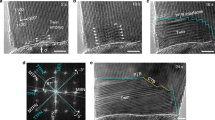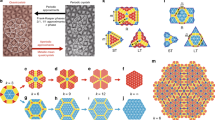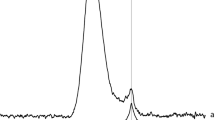Abstract
It has been known for several years that anomalous structures can occur in the early stages of particulate growth. Ino1 and Ino and Ogawa2 for gold on rocksalt and Allpress and Sanders3 for nickel on mica found small polycrystalline nuclei which they interpreted as multiply-twinned particles (MTPs). These particles can be considered as 5 or 20 f.c.c. tetrahedra joined by twin boundaries to give decahedra or icosahedra (Fig. 1). As the tetrahedra do not assemble to a completely space filling structure, either elastic strains or grain boundaries are required to complete the particles. More recently, MTPs have been observed in the early stages of growth for all f.c.c. metals in certain conditions. Gillet4 has recently reviewed the field whilst Hayashi et al.5 give extensive results for f.c.c. metals in argon smokes. The possible significance of MTPs in heterogeneous catalysts was first suggested by Allpress and Sanders6 and investigated by Avery and Sanders7. They found, however, that at most 2% of particles 100–350 Å in size for Ni, Au, Pt and Pd on γ-alumina were multiply twinned. We report here the presence of considerable numbers of multiply-twinned particles in various heterogeneous metal catalysts, in particular silver on α-alumina. The particles can have quite large dimensions up to ∼2,000 Å. Attention is drawn to the possible significance of some special sites on these particles which have no counterpart on single crystal surfaces, and to the unusual distribution of surface faces.
This is a preview of subscription content, access via your institution
Access options
Subscribe to this journal
Receive 51 print issues and online access
$199.00 per year
only $3.90 per issue
Buy this article
- Purchase on Springer Link
- Instant access to full article PDF
Prices may be subject to local taxes which are calculated during checkout
Similar content being viewed by others
References
Ino, S. J. phys. Soc. Jap. 21, 346 (1966).
Ino, S. & Ogawa, S. J. phys. Soc. Jap. 22, 1365 (1967).
Allpress, J. G. & Sanders, J. V. Surface Sci. 7, 1 (1967).
Gillet, M. Surface Sci. 67, 139 (1977).
Hayashi, T., Ohno, T., Shigeki, Y. & Uyeda, R. Jap. J. appl. Phys. 16, 705 (1977).
Allpress, J. G. & Sanders, J. V. Austr. J. Phys. 23, 23 (1970).
Avery, N. R. & Sanders, J. V. J. Catal. 18, 129 (1970).
Saito, Y., Yatsuya, S., Mihama, K. & Uyeda, R. Jap. J. appl Phys. 17, 1149 (1978).
Frank, F. C. Discuss. Faraday Soc. 5, 48–186 (1949).
Ino, S. J. phys. Soc. Jap. 27, 941 (1969).
De Wit, R. J. Phys. C5, 529 (1972).
Author information
Authors and Affiliations
Rights and permissions
About this article
Cite this article
Marks, L., Howie, A. Multiply-twinned particles in silver catalysts. Nature 282, 196–198 (1979). https://doi.org/10.1038/282196a0
Received:
Accepted:
Issue Date:
DOI: https://doi.org/10.1038/282196a0
This article is cited by
-
Atomically resolved Au52Cu72(SR)55 nanoalloy reveals Marks decahedron truncation and Penrose tiling surface
Nature Communications (2020)
-
Unexpected Kirkendall effect in twinned icosahedral nanocrystals driven by strain gradient
Nano Research (2020)
-
Unusual 4H-phase twinned noble metal nanokites
Nature Communications (2019)
-
Monodispersed bimetallic PdAg nanoparticles with twinned structures: Formation and enhancement for the methanol oxidation
Scientific Reports (2014)
-
Solid State Pathways to Complex Shape Evolution and Tunable Porosity during Metallic Crystal Growth
Scientific Reports (2013)
Comments
By submitting a comment you agree to abide by our Terms and Community Guidelines. If you find something abusive or that does not comply with our terms or guidelines please flag it as inappropriate.



